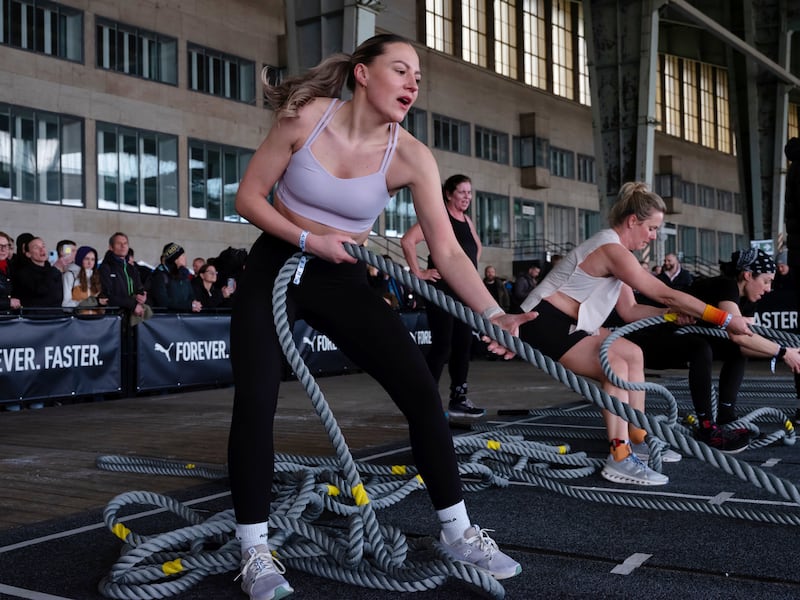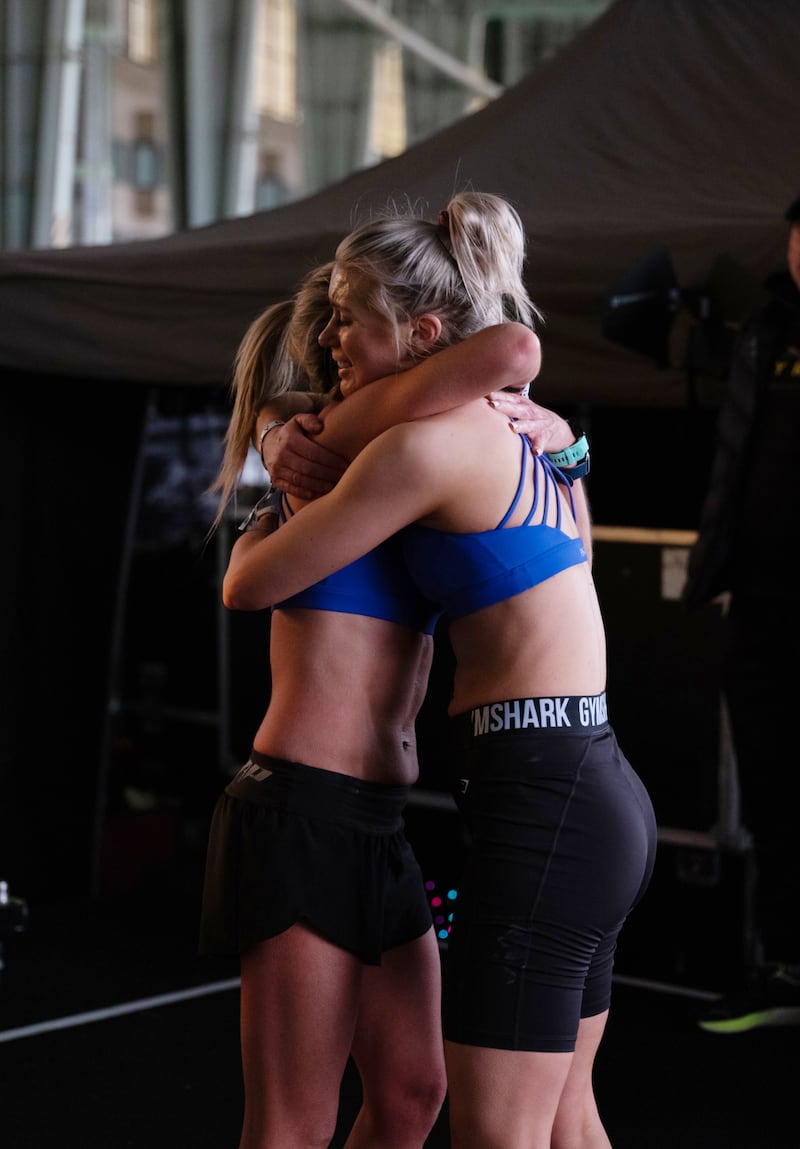The men at the starting line at Hyrox in Berlin practically hummed with nervous enthusiasm. A few dozen racers, part of an early morning heat, stood watching the steady tick of a five-minute countdown, displayed on a huge television overhead.
Dramatic string music played on tinny loudspeakers. A booming voice intoned a rallying cry: “This is the moment you’ve been training for!”
Lights twinkled. Spectators cheered.
For the founders of the fitness race Hyrox, 55-year-old Christian Toetzke and 39-year-old Moritz Furste, this kind of kitschy spectacle was always part of the plan. The original brief, when they introduced the race in Hamburg, Germany, in 2017, was “to create an event that is a €200,000 production that looks like a €2 million production”, Furste said.
READ MORE

Hyrox’s “modern entertainment and light effects create a very special feeling”, Toetzke said, one that he hopes will create a “new proposition for mass participation events”.
A Hyrox race combines running with several functional fitness movements, such as the farmer’s carry, the weighted lunge and the burpee broad jump. It takes about 90 minutes to complete, on average, although elite racers can finish in under an hour. The race has exploded in popularity since the end of the pandemic – more than 175,000 people are expected to participate in the more than 60 races that Hyrox has organised for 2024 – including an “electrifying two-day extravaganza” at the RDS in Dublin next November 16th and 17th.
Hyrox is not the first fitness race to emerge from nowhere and gain a cult following. What distinguishes it from fads like Tough Mudder and Spartan, according to Hyrox fans, is its athletic simplicity. “Tough Mudder and Spartan are an experience that has a sport aspect to it,” said 34-year-old Hunter McIntyre, a full-time fitness racer who holds the world record in Hyrox. “Hyrox is a sport that is an experience.”
[ How to play catch-up on your mini marathon trainingOpens in new window ]
When McIntyre would tell people that he was doing a Tough Mudder, “it was almost embarrassing”, he said. Now, when he tells people that he does Hyrox, “there’s a level of respect to it”, he said. “Usually when you ask someone if they did a Tough Mudder, it’s like they went with their office, and they got pictures and wore funny outfits,” McIntyre said, whereas Hyrox, he added, “is truly a sport”.
As a sport, Hyrox draws heavily from CrossFit, including the equipment it uses. Ski Erg and rowing machines, kettlebells, ropes and weighted sleds are common fixtures of CrossFit gyms. Some Hyrox movements, such as the wall ball shot, were created by CrossFit, although CrossFit workouts use these movements only occasionally, following founder Greg Glassman’s ethos of “constantly varied high-intensity functional fitness”.
Toetzke said he and Furste workshopped the Hyrox format at CrossFit gyms before the race was introduced. He added that although he tried CrossFit himself, he “thought it was a bit too much, a bit too hard, too injury-heavy”.
CrossFit involves many complex Olympic lifts and gymnastics skills, which can be difficult to master and, to some, dangerous to learn. Hyrox has avoided those kinds of techniques, sticking instead to simple movements that, Toetzke said, “are very hard to do wrong in a way that can hurt your body”.
Despite or perhaps because of the similarities between the sports, Hyrox has deliberately positioned itself as the safer, more accessible alternative. “Look, candidly I think they’re smart trying to leverage that,” Don Faul, CrossFit’s CEO, said in response to these claims. “When you’re trying to enter a new space, you define yourself against the incumbent, the company that has defined the category. We’ve seen a variety of folks in the fitness space trying to take the same angle.”

Faul (47) a former platoon commander in the US Marines, said the apparent difference in accessibility between CrossFit and Hyrox is really just a difference in perception. “The vast majority of people in our gyms are everyday folks, not elite athletes,” he said, adding that people stepping into a CrossFit gym for the first time might be “incredibly surprised by how welcoming and accessible it is”.
Although many local CrossFit gyms host their own events, the only in-person competition the company organises is its annual CrossFit Games, which is for a handful of elite athletes and is meant to crown “the fittest on earth”. That’s another reason CrossFitters often join Hyrox. It offers a chance to test their fitness live.
Although it’s difficult to say precisely how much overlap there is between CrossFit and Hyrox, Chris Hinshaw, a 60-year-old coach who trains athletes in both sports, said that “most of the people who are getting into Hyrox got their start in CrossFit”. Many of the racers on the Hyrox podiums are also elite CrossFit stars, including Mal O’Brien and Mirjam von Rohr, two of the top CrossFitters in the world.
[ Why don’t more men do yoga?Opens in new window ]
Hyrox claims to have more than 2,500 affiliate gyms around the world (the official website lists at least one location in most Irish counties) at which athletes can train for the public races. Toetzke and Furste initially said “about 10 per cent” of these affiliates were also CrossFit gyms. In Berlin, 16 of 18 listed on the Hyrox website also offered CrossFit classes. Asked for clarification, Hyrox revised their estimate to 22 per cent. Faul said that, although CrossFit does not track the number, he “would be surprised if it was that low”.
Furste seemed vexed to have to address the subject of CrossFit’s influence on Hyrox. “I absolutely don’t like this conversation,” he said. “We don’t want to take anything away from them. We love the training methodology. But in the end, apart from the functional workouts, it has nothing to do with us.”
Each sport seems to be benefiting from the other. Hinshaw said that Hyrox and CrossFit are “really a perfect pair”, pointing out that offering both sports is a good way for a gym owner to increase member retention. “A lot of people think they’re competitive with one another, and that is not at all true,” he said. “By the nature of who these athletes are, they’re always chasing the shiny new object.”

The question now is whether Hyrox can endure – or even continue to grow – as the blush of novelty wears off. It could also, like CrossFit, deepen in intensity while narrowing in appeal – it might inspire passion but the passion of the devoted few.
Toetzke doesn’t think so. “I don’t see the risk of becoming a sport only for committed people,” he said. “We are looking to the success and longevity and sustainability of the marathon.”
Becoming as popular as marathon running, of course, is a rather lofty ambition for an organisation with events that are a fraction of a marathon’s size. (Hyrox New York, taking place June 1st, will have less than 10 per cent of the New York Marathon’s participants.) But that, long term, is the goal. “We really believe that this is the potential,” Toetzke said. – This article originally appeared in the New York Times
- Sign up for push alerts and have the best news, analysis and comment delivered directly to your phone
- Find The Irish Times on WhatsApp and stay up to date
- Listen to our Inside Politics podcast for the best political chat and analysis





















